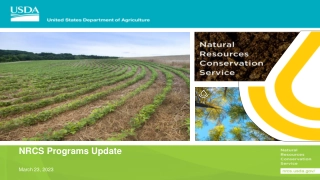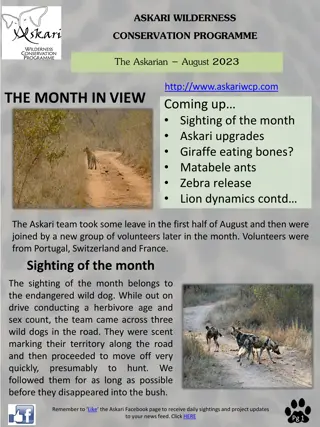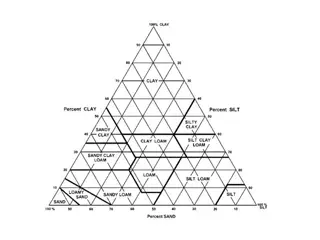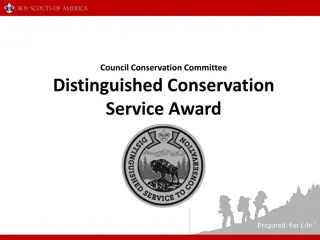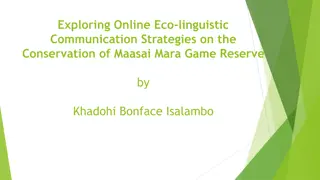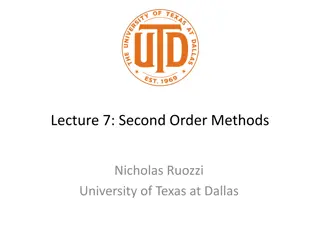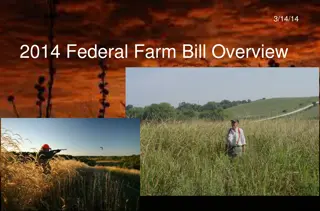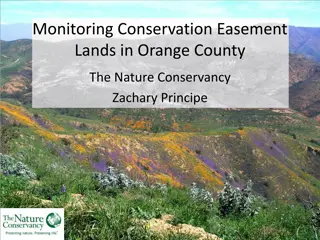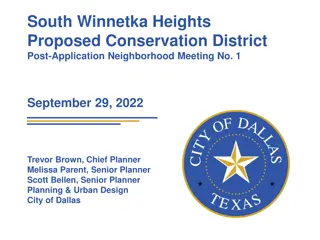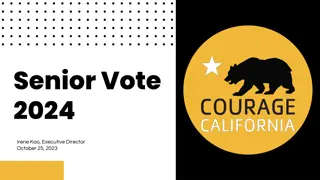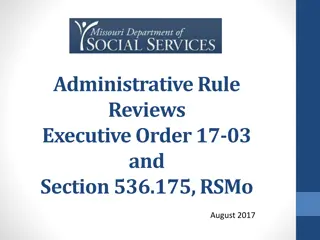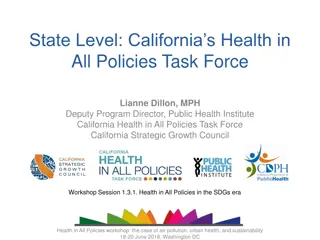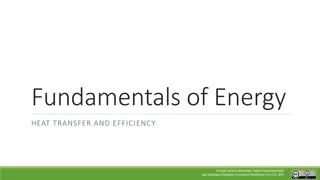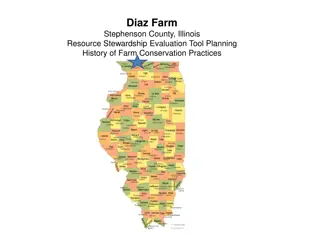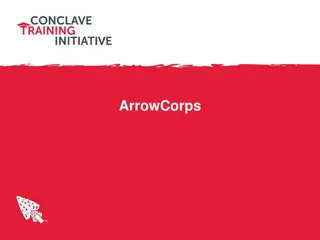
Update on Executive Order B-37-16 Making Conservation a California Way of Life
This content provides an overview of Executive Order B-37-16 issued on October 5, 2016, focusing on water conservation initiatives in California. It outlines the directives related to using water wisely, eliminating water waste, and strengthening local drought resilience. The content highlights key components, agency actions, and timelines associated with the implementation of the executive order.
Download Presentation

Please find below an Image/Link to download the presentation.
The content on the website is provided AS IS for your information and personal use only. It may not be sold, licensed, or shared on other websites without obtaining consent from the author. If you encounter any issues during the download, it is possible that the publisher has removed the file from their server.
You are allowed to download the files provided on this website for personal or commercial use, subject to the condition that they are used lawfully. All files are the property of their respective owners.
The content on the website is provided AS IS for your information and personal use only. It may not be sold, licensed, or shared on other websites without obtaining consent from the author.
E N D
Presentation Transcript
1 Update on Executive Order B-37-16 MAKING CONSERVATION A CALIFORNIA WAY OF LIFE OCTOBER 5, 2016
2 Presentation Overview Introduction Overview of Executive Order B-37-16 Implementation and Agency Actions Timeline and Next Steps
3 Use Water More Wisely EO B-37-16 Overview Eliminate Water Waste Issued May 9th, 2016 Strengthen Local Drought Resilience Four key components, with 13 directives. Improve Agricultural Water Use Efficiency and Drought Planning
4 EO Overview: Use Water More Wisely EO Directives #1 through #3: Adjust emergency conservation regulations, develop proposal to achieve a mandatory reduction that builds off 25% previous conservation targets Set water use targets by establishing statewide standards for indoor water use, outdoor water use, water loss, and CII (commercial, industrial, and institutional) Permanently require monthly reporting from suppliers on water use, conservation, and enforcement
5 EO Overview: Eliminate Water Waste EO Directives #4 through #7: Permanently prohibit practices that waste water Minimize system leaks Accelerate data collection, improve management, and prioritize capital projects to reduce water waste Certify innovative water conservation and water loss detection and control technologies that also increase energy efficiency
6 EO Overview: Strengthen Local Drought Resilience EO Directives #8 through #10: DWR to strengthen requirements for urban water shortage contingency plans (WSCPs), creating common standards and planning for at least five years of drought. For areas not covered by a WSCP, DWR shall work with counties to facilitate improved drought planning for small water suppliers and rural communities.
7 EO Overview: Improve Ag Water Use Efficiency and Drought Planning EO Directives #11 through 13: DWR and CDFA update existing requirements for Agricultural Water Management Plans DWR to permanently require completion of Agricultural Water Management Plans by water suppliers with over 10,000 irrigated acres of land
8 EO Overview: Additional Elements EO also includes requirement that: DWR, Water Board, and CPUC shall develop methods to ensure compliance with the provisions of the Order, including technical and financial assistance, agency oversight, and, if necessary, enforcement action by the Water Board to address non-compliant water suppliers.
9 Agency Implementation ACTIONS THE EO AGENCIES WILL TAKE TO IMPLEMENT THE EXECUTIVE ORDER
10 EMERGENCY REGULATIONS Implementation: Use Water More Wisely WATER USE TARGETS AND STANDARDS REPORTING REQUIREMENTS
11 Implementation: Use Water More Wisely Modified emergency drought regulations (EO #1) Board will develop proposal to achieve mandatory reduction to build off 25% (EO #1) Board and DWR to make monthly reporting permanent (EO #3)
12 Implementation: Use Water More Wisely State agencies to establish a long term framework for new water use targets based on water budgets calculated from standards for 4 sectors (EO #2) Indoor residential Outdoor irrigation Commercial, Industrial, Institutional (CII) Distribution System Loss
13 Implementation: Efficiency Standards Indoor Standard: Provisional standard of 55 GPCD Revise downward in 2018, based on additional studies, to be achieved by 2025. Outdoor Standard: Provisional standards based on Model Water Efficient Landscape Ordinance: 0.8 reference Evapotranspiration (Et) (pre-2010) 0.7 reference Et (2010-2015) 0.55 (residential) or 0.45 (commercial) post 2015 1.0 for special landscapes Revise downward in 2018 based on analysis of existing data and pilot project with 30 agencies
14 Implementation: Efficiency Standards Commercial, Industrial, & Institutional (CII) Proposed approach: Establish performance measures All dedicated irrigation accounts will be on a budget using outdoor standards Require classification (NAICS) by (2021), develop benchmarks. Require all mixed meter accounts to split off landscape greater than a size threshold to dedicated irrigation accounts (or equivalent technology) by 2021. Audits and water management plans for reporting efficiency in CII water use. Audits and plans for subset of CII customers, based on volume, percentage, or number. Water Loss SB 555 Standards State Water Board rulemaking to commence in 2019 with standards set in 2020 Will include real and apparent losses
15 Draft Framework: Water Use Target Calculation Targets calculated by adding the volume or GPCD from sector budgets, but not CII Illustrative Target Calculation with Sample Numbers: Sector Indoor Residential Outdoor Landscape Water Loss TARGET Budget (vol.) 4,570,744 3,729,166 530,560 10,482,849 (CCF) Budget (GPCD) 55 44 7 128 (GPCD
16 Implementation: Use Water More Wisely Progress reports beginning in 2019 to describe actions suppliers will take to meet 2025 requirements. Compliance in 2025 reporting period, as documented in 2026 compliance report and 2025 UWMP (submitted in July 2026) State agencies are developing methods to support compliance from 2021 through 2025.
17 Implementation: Eliminate Water Waste MINIMIZE WATER LOSS & INNOVATIVE TECHNOLOGIES
18 Implementation: Eliminate Water Waste Identify urban retail water suppliers with high water losses. Offer technical assistance Funding assistance for small suppliers through the Drinking Water State Revolving Fund Board to develop permanent regulations prohibiting certain practices that waste potable water (EO #4) Other actions (data, loan programs, ag plans, reduce non-revenue) Energy Commission to certify innovate water conservation and loss detection and control technologies that increase efficiency.
19 Implementation: Energy Commission Workshop Tuesday, October 11, 2016 10:00 a.m. CALIFORNIA ENERGY COMMISSION, Rosenfeld Hearing Room 1516 Ninth Street First Floor Sacramento, California 95814 Phone and webinar options available http://docketpublic.energy.ca.gov/PublicDocuments/16-OII- 01/TN213881_20161004T081745_Corrected_Public_Workshop_Innovative_Water_Conservation_an d_Wat.pdf Purpose: to provide opportunity to respond and discuss request to gather information on innovative water conservation and water loss detection and control technologies as part of the Governor s Executive Order. Contact Sean Steffensen (Sean.Steffensen@energy.ca.gov)
20 WATER SHORTAGE CONTINGENCY PLANS Implementation: Strengthen Local Drought Resilience IMPROVE DROUGHT PLANNING FOR SMALL WATER SUPPLIERS AND RURAL COMMUNITIES
21 Implementation: Strengthen Drought Resilience Plan: Develop supplier-specific WSCP with defined elements Assess: Defined process to annually assess conditions and respond with supplier-appropriate actions Respond: Implement supplier appropriate actions already defined in WSCP (based upon assessment results) Reporting: Submit annual assessment to State agencies Submit WSCP every 5-years with UWMP Submit monthly status when certain stages activated
22 Implementation: Strengthen Drought Resilience 9 Proposed Elements of WSCPs: 1. Defines Annual Assessment process and timeline 2. Defines local criteria that would initiate responses 3. Defines local response actions to mitigate actual or potential shortage: 4. Establishes a Communications Plan with budgets, messages, methods, etc., that vary with responses 5. Demonstrates existing/new implementation authority 6. Addresses financial elements 7. Articulates reporting process, data, and timing 8. Details Customer Compliance and Enforcement mechanisms 9. Establishes a Review/Improvement Process and details a customer exemption process
23 Assessment and Stress Test Proposed variants: 1. Submitted to the State annually, current year supply/demand assessment plus five year stress test 2. Submitted to the State annually, current year supply/demand assessment and submit to State a five year stress test with UWMP every five years.* *No requirement for the water supplier to review or report their 5 year stress test each year
24 Implementation: Strengthen Drought Resilience Drought Planning for Small Water Suppliers and Rural Communities Currently have agricultural and urban water supplier WSCPs, county self supplied domestic users pilot project, and CRWA rural WSCPs. Looking how to integrate these and establish a broader county wide WSCP to address rural communities and small water systems that are not a component of WSCPs. Looking how to integrate the county approach into a Local Hazard Mitigation Program Meeting/webinar October 13, 2016 to discuss issues, obstacles, roles and responsibilities related to implementing this EO Action
25 Implementation: Improve Ag Water Use Efficiency & Drought Planning AGRICULTURAL WATER MANAGEMENT PLANS
26 Implementation: Ag Water Use CDFA and DWR Roles Agricultural Advisory Group CDFA Houses the State Water Efficiency and Enhancement Program Collaboration Process Feedback on strategies to address EO Directives Representation on Agricultural Advisory Group DWR Update existing Ag Water Management Plan requirements
27 Implementation: Ag Water Use Proposing 2-element framework: 1. Outcome/objective based planning 2. Measure efficiency by: 1. Water Balances 2. Calculation of water management fractions Drought management plans as part of AWMPs Reporting Agricultural water suppliers with over 10,000 acres of irrigated land adopt AWMPs by December 31, 2020 and submit them to DWR within a month of adoption to comply with updated AWMP requirements.
28 Next Steps and Timeline DELIVERABLES, REPORT DEVELOPMENT, AND TIMELINE
29 Stakeholder Outreach Listening sessions immediately following EO The EO requires stakeholder engagement: Developed Urban and Agricultural Advisory Groups Additional Technical Workgroups Public workshop following release of Framework Report
30 Framework Report The EO requires release of draft framework by January 10, 2017. Framework will include proposed strengthened efficiency standards, updated draft WSCP requirements, updated draft Ag Management Plan, and other required elements. Will identify if legislative and/or regulatory changes are needed to implement the framework Estimated release of public draft report in early November, 2016 Public comments and input received, will be considered in development of final report Final Report released January 10th, 2017 Public workshop following release
31 EO B-37-16 | Timeline We are here January 10, 2017 Final Report Stakeholder Advisory Group Meetings and Workshops Next Stages Implement New Requirements If Applicable Legislative Changes If Needed Summer Fall 2016 Develop Approach & Draft Recommendations November 2016 Public Draft and Public Workshop (Nov. 4) Public comments Due (Nov. 14)
32 Questions?

